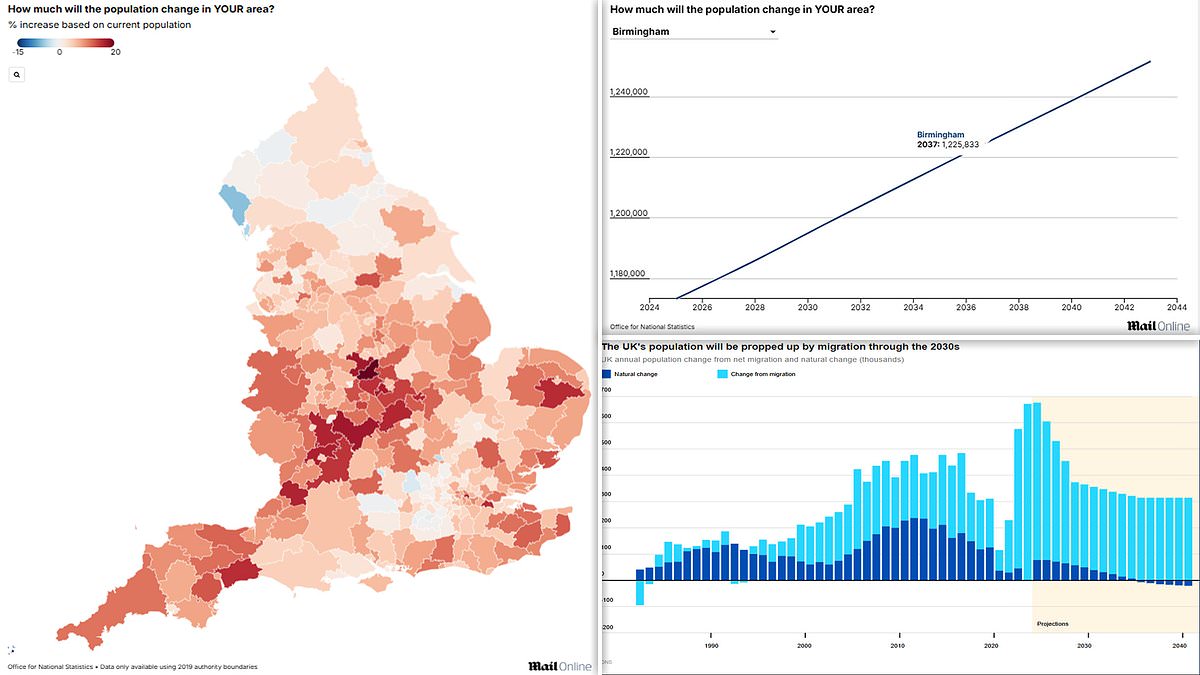The population of almost every part of England is going to grow over the next two decades, according to official projections.
Some areas may increase in size by 20 per cent, with immigration thought to be the driving force across many postcodes.
Another 23,400 people will be packed into North West Leicestershire by 2043, the Office for National Statistics (ONS) estimates.
Around 110,000 residents currently live in the district, home to the towns of Ashby-de-la-Zouch, Castle Donington and Coalville.
It means its population is expected to increase by 20.5 per cent.
ONS bosses say their projections take into account fertility and death rates, age of the area’s current population, and migration.
Soaring populations heap even greater pressure on housing, schools and the ailing NHS.
Behind North West Leicestershire in terms of population increases come Stratford-Upon-Avon (17 per cent) and South Derbyshire (16.9 per cent)
Blaby (16.5 per cent) located in Leicestershire’s south west region, and Tewkesbury (16.4 per cent) in Gloucestershire round out the top five.
The Isles of Scilly, by comparison, is likely to see a reduction of 264 people over the next 18 years – or nearly 15 per cent of its total population.
Parts of leafy outer London are also likely to see population regression, the estimate suggest.
Ealing, for example, is predicted to shrink by 0.03 per cent to approximately 338,000 residents.
Headcounts in four Surrey districts, Woking, Surrey Heath, Guildford and Elmbridge, are also expected to contract.
In total, 19 authorities are expected to see a population decrease.
The biggest shift backwards, in regards to raw numbers, is slated to be Luton. It will, under the estimates, lose 7,500 residents.
The ONS predicts England’s population could jump from around 58million in 2025 to nearly 62million in 2043.
Solely looking at raw numbers instead of rates, Birmingham is projected to see the biggest population boom.
An extra 78,000 extra people will end up calling the UK’s second city home.
Cornwall is also expected to see another 67,000 people reside there.
Tower Hamlets, crowned Britain’s most crowded borough, ranks just outside the top 10 for expected population growth.
Since the early 1990s to last year, the East London borough has seen its population double from 166,300 to just shy of 328,600.
The ONS expects another 55,000 people to be living there come 2043.
Experts claim Tower Hamlets’ growth explosion lays bare the staggering reality of uncontrolled immigration.
Almost half of residents living there were born outside of the UK, 46.8 per cent, as per the last Census.
Immigration levels have since shot to all-time highs, meaning the true figure within Tower Hamlets now could be even higher.
In the year to June 2023, the ONS said 1.32m people immigrated here, mainly from India, Nigeria, Pakistan, China and Zimbabwe. Another 414,000 emigrated.
It meant around 906,000 people, the equivalent to Leicester-sized cities, settled in Britain.
Migration is expected to add around 600,000 people to Britain’s headcount every year until around 2026.
The government projects that by 2030, migration will be the only factor pushing up Britain’s population year-on-year as the country’s death rate overpowers the birth rate.
Dr Ben Brindle, from the Migration Observatory at Oxford University, said migrants could help address Britain’s ageing population problem.
He told : ‘One of the key opportunities and questions around migrants and their role in Britain is whether they are net positive or negative to the economy and research suggests they are somewhat neutral.
‘Potentially they could be filling vacancies within adult social care, which will be a key sector as Britain’s population ages.’
Part of the reason why areas outside of London could see the biggest increases, Dr Brindle says, is down to the national picture of these types of roles, which tend to be focused away from the capital.
The analysis comes at a time when Sir Keir Starmer faces renewed pressure to make good on his party’s manifesto promise to ‘smash the gangs’ behind illegal small boat migration to UK shores.
Since Labour’s election win, more than 30,000 have made the crossing.
Soaring populations will pile pressure on ministers to build millions more homes.
Builders aren’t even hitting the current target of 300,000 homes a year.
In order to meet Labour’s building blitz pledge, some councils have been to build seven times as many houses.
Thousands more GPs will also be needed to keep up.
Under the widely accepted ‘safe’ limit, one fully-qualified, full-time equivalent GP is needed for every 1,800 patients.
In February there were just 28,000 in England – well below the 35,500 needed by 2042 is current trends continue.
